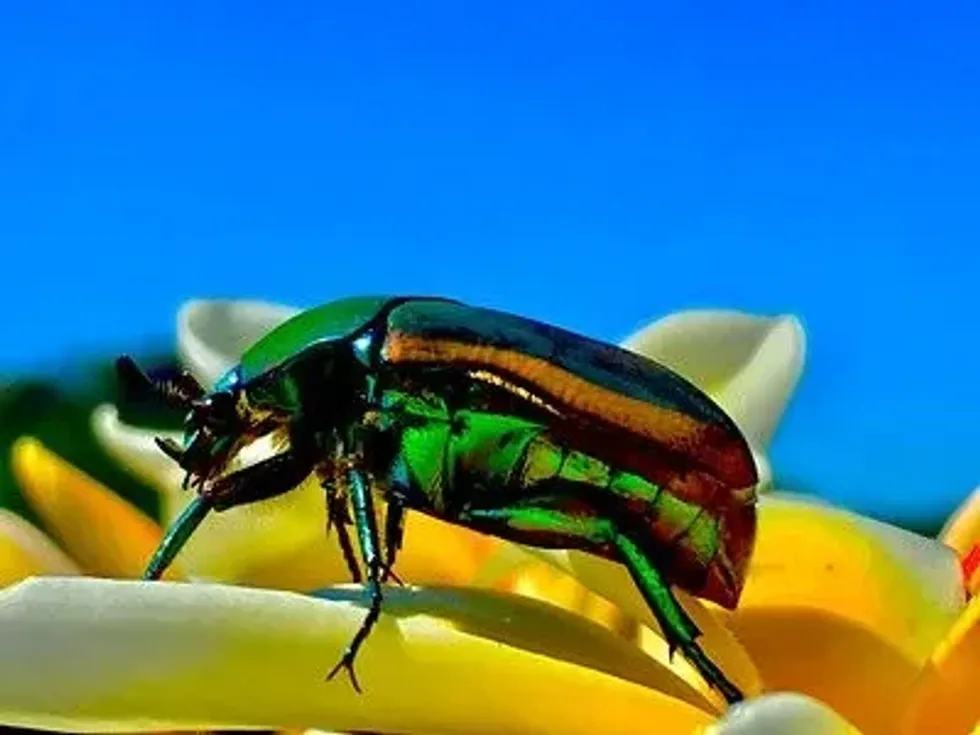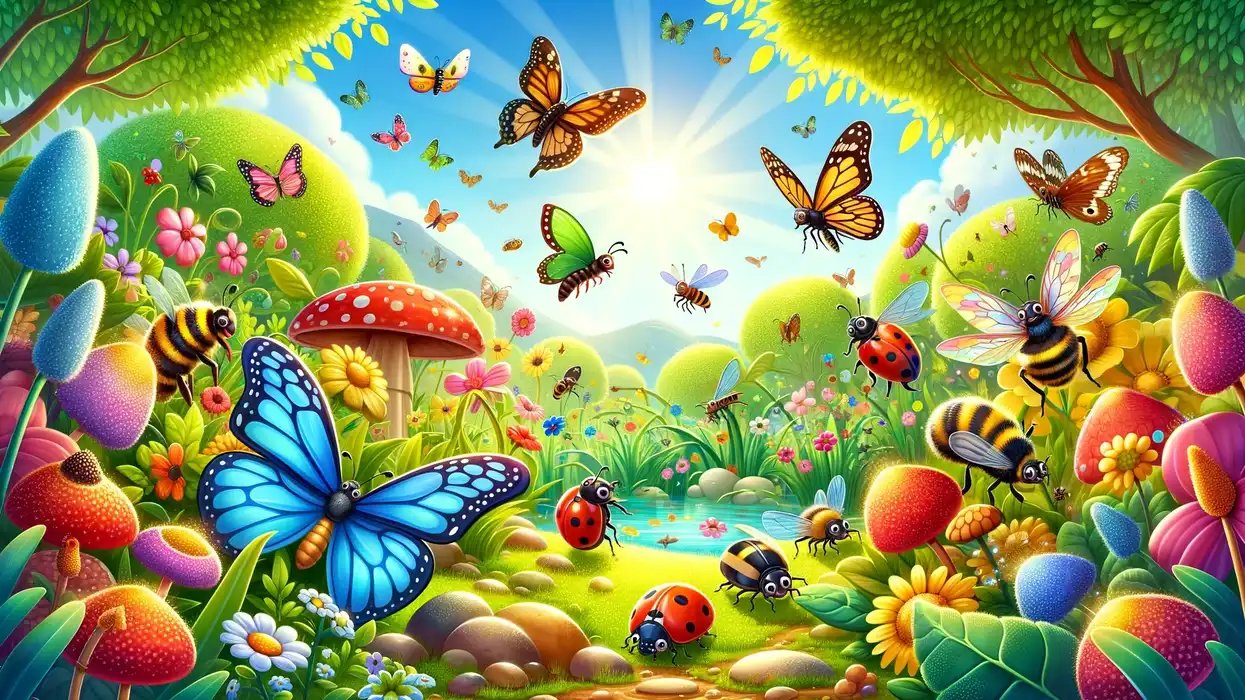What's that bug? It's the Green June beetle!
Found in the North of California, this animal is well known for its violent and destructive tendencies. The Green June beetle - Texas, particularly presents problems for farmers.
At less than a few inches, these creatures spend their nights lazing in the soil and coming up to the surface during the day to feed and destroy human crops and fruits. They are also called the June Bug and get their name from the month of June, which is when they are the most active.
Farmers have tried various strategies to be rid of them (particularly in the grub stage) but most attempts have been unsuccessful except for the milky spore strategy. Do you think you could do better and take care of the grubs as soon as they leave their home turf and emerge on the surface?
If so, then read on for some fun facts below! You might also enjoy reading about the Atlas beetle and click beetle.
Green June Beetle Interesting Facts
What type of animal is a Green June beetle?
The Green June beetle is a type of beetle.
What class of animal does a Green June beetle belong to?
Since they too have joint legs, the Green June beetle is an arthropod.
How many Green June beetles are there in the world?
Due to a lack of research, there is no number about how many June beetles are there in the world.
Where does a Green June live?
The Green June beetle is really attracted to decaying organic matter, either found in the farm or the woods making it their habitat. They can be seen burrowing several inches deep into the soil, where they prefer to stay even as adults.
What is a Green June beetle's habitat?
The Green June beetle is an insect primarily found in the United States, in places such as Texas, California, and more. Their habitat is usually a place with lots of soil, with overripe or ripening fruits nearby.
The weather is generally warm, and there is plenty of water and holes in this soil for them to lay their eggs in when they become adults.
Who do Green June beetles live with?
The Green June beetles live on their own usually living deep in damp, cold soil. They may come together once a year to mate. However, if there is a scarcity of food, they may be seen crowding to a given fruit or to plants.
How long does a Green June beetle live?
The Green June beetle cycle lasts for about a year. In their life cycle, this insect starts as eggs in the soil, into larvae, then the white grubs, and then finally reach adulthood.
How do they reproduce?
The male and the female Green June beetles will mate for about three days, usually in the mornings. The female insect then heads over to soft, deeply dug soil and lays her eggs.
These eggs hatch into larvae where they stay in the soil. The Green June beetle larvae feed and finally grow into the Green June beetle grub.
At this point the grub leaves the soil and comes to the surface, looking for food. There, grubs will feed on anything they come across and then reach the stage of adult.
What is their conservation status?
The Green June beetle is classified as a species of Least Concern. This is because they are kept in control by their natural predators, who eat them in the soil before they can become adults. Humans also attempt to practice pest control on their turf plants, but all it does is drive this insect back into the soil temporarily.
Green June Beetle Fun Facts
What do Green June beetles look like?
The Green June beetles look like a scarab. They are about an inch long and spend a lot of their time hiding in the soil.
The adults have a metallic green body, with six legs, two eyes, wings, and wing covers. Unlike the adults, the young, white grubs, look like centipedes without legs. Their larvae look like discolored, small eggs.
How cute are they?
Well, you might think they are cute, but they are actually not liked by farmers at all. These insects end up feeding on fruit, plants, grass, and other turf-based vegetation and are classified as pests.
The adults might look a little cool with their colors, but do not be fooled. These soil-dwelling creatures are out to destroy your gardens, farms, and plants.
How do they communicate?
They do not have any loud calls or sounds. Rather, this species communicates using scent, by rubbing their mouth parts together, and by rubbing their own limbs together. Even in this, we have seen only the adults communicate, once they have left the soil. Grubs who have not left the soil, are not seen communicating at all.
How big is a Green June beetle?
The Green June beetle as an adult can be fairly large. They are up to 15-22 mm big (almost an inch long), which means almost half the size of the Rhinoceros beetle (when they are adults). Despite their competitive size, these animals prefer to stay several inches into the soil.
How fast can a Green June beetle move?
The adult Green June beetle (Cotinis nitida) can move relatively fast for its size. Since they feed on decaying organic matter and are mostly on the run from predators, they have to be fast. If in danger, they burrow many inches below the surface, where they stay until the danger on the turf has passed.
How much does a Green June beetle weigh?
The adult Green June beetle is very light, coming up to 20 g at most. There have been cases of even grubs weighing more than 10 g, but those cases are rare.
What are their male and female names of the species?
There are no specific names for the male and the female of the species.
What would you call a baby Green June beetle?
When they are just born, you can call the baby Gren June beetle larvae. When they grow up a little, you can call them grub. These grubs then eventually grow into adults.
What do they eat?
This inch-long species is very attracted to all things decaying. They can be seen feeding on fruit, plants, grass on the turf, things like corn, oats, overripe vegetables, and more. The larvae end up feeding on, even more, often ending up eating soil too.
Are they rare?
The Green June beetles may be endemic to the United States, but they are not rare at all. These insects are classified as pests, and often cause trouble for farmers and orchard keepers because they feed on anything and everything around them.
They usually come around June-August, in preparation for their mating and laying eggs, and can be seen in droves across farms, gardens, orchards, and other vegetation in the United States.
Would they make a good pet?
Unless you enjoy their metallic green color, no, they would not. They are not particularly useful and are more destructive than anything, especially when they are larvae or in their grub stage.
As grubs, they will not hesitate to destroy the root systems of your plants, chew and mulch the roots of surface to turf grasses, and in general wreak havoc.
They become less aggressive when they reach the stage of adult, but still remain an annoying pest you would not want in your home. So, their only appeal is their charming green color, which has been a subject of much admiration amongst researchers.
Did you know...
Many people mistake the Green June beetles for the Figeater Beetle. The main difference between the Figeater beetle vs. Green June beetle is of diet, size, and grubs.
The Figeater beetle does not feed on decaying matter and prefers eating flowers, nectar, pollen, and fresh fruit. Their grubs move on their backs, and their size can be up to 1.25 in long.
The Green June beetle, on the other hand, prefers to eat rotten, decaying organic matter, has grubs that do not crawl on their backs, and is smaller at around an inch or so in size. Minor differences, we know, but it's the little things that make all the difference, right?
Are Green June beetles harmful?
Yes, the Green June beetles are harmful. They destroy and feed on fruit, turfgrass, soil, plants, nuts, and many other forms of vegetation.
Once the eggs hatch, the Green June beetle grub is even more destructive and becomes a real problem. The Milky Spore was developed to keep them at bay. This is a type of disease-specific only to beetle larvae and is introduced in the larvae to prevent them from reaching adulthood.
This treatment is practiced on larvae and grubs, and if done across the surface properly can take two to three years to be introduced. Once it is done, it can last up to 10 years.
So yes, they (even as grubs) are a menace to turf grasses, lawns, and other vegetation found on the surface. But are they dangerous to humans? No, they are not. The Green June beetle bite is barely felt at all and leaves no lasting impact.
Do Green June beetles fly?
They have wing covers, and wings under them, so technically, they can fly. But they can not fly like birds.
They can only fly for short distances, helped on by hops and wind currents. This is because they have an exoskeleton that can weigh them down, and have small wings that are not suited to long flights. So, no, flying might not be this creature's turf quite yet.
Here at Kidadl, we have carefully created lots of interesting family-friendly animal facts for everyone to discover! Learn more about some other arthropods, including water beetle or ground beetle.
You can even occupy yourself at home by drawing one on our Green June Beetle coloring pages.









